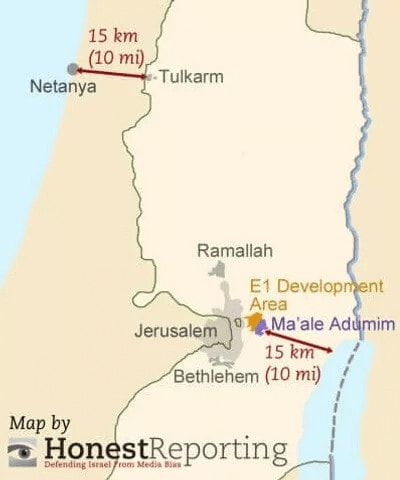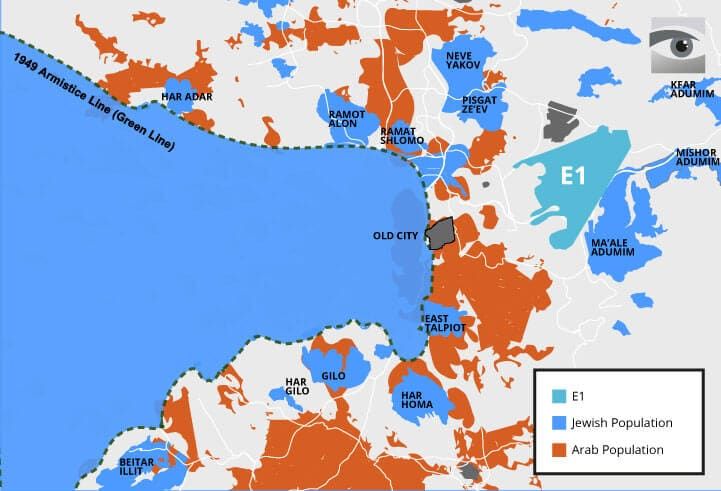There are numerous flashpoints in the Arab-Israeli conflict, including competition for control over precious water resources, sacred places and the status of Jerusalem. Few are as little-understood yet as potently explosive as the small parcel of land due east of Jerusalem known as E1. For Israel, E1 represents both a crucial security asset and economic growth opportunity. In the eyes of the international community, however, building there is tantamount to killing off the two-state solution.
Indeed, Israeli prime minister Benjamin Netanyahu has spoken of building in E1 as having “enormous significance,” whereas according to PLO Secretary-General Saeb Erekat, if any construction is carried out, it would signal “the end of two states.”
So which is it?
Join the fight for Israel’s fair coverage in the news
What and Where is E1?
The term E1 was coined by Israel’s Ministry of Housing to describe a small patch of land located just outside of Jerusalem’s municipal boundaries, on the hills between Ma’aleh Adumim and Jerusalem.
The area covered by E1 is located within the municipal borders of the Israeli settlement city of Ma’aleh Adumin, and abuts Abu Dis, Azariya, Anata and A-Zayim – all Arab villages and towns. Since 2004, Israel has intended to build in this area, but international pressure has led to Israel refraining from advancing its plans.

Situated between the eastern slopes of the Mount of Olives and up towards Ma’aleh Adumim, due east, and just outside of Jerusalem’s municipal borders, the 12,000 dunams (12 sq. kilometer) patch of hilly territory has the potential to generate international headlines and global condemnations.
But why?
In order to understand better, it’s important to see E1 from two competing perspectives.
The Significance of E1 for Israel
To Israelis, the threat of seeing Jerusalem, Israel’s capital, cut off as it was in the 1948 War of Independence is intolerable. No country would allow itself to be cut off from its capital, and following the 1967 Six Day War, Israel has built up a ring of settlements to act as buffer zone around Jerusalem to protect it from invasion and isolation by invading armies.

Beyond the security advantages it holds for Israel, E1 is also the last significant piece of convenient and unsettled real estate close to Jerusalem. With Jerusalem’s growth already limited to its north and south by Ramallah and Bethlehem respectively, and with green groups lobbying effectively to place off-limits any plans for building in the forest land to the west of the city, the sole direction in which Jerusalem can grow naturally is eastwards. With the city facing a serious housing shortage, E1 is the only viable location where tens of thousands of homes can be built.
Things, however, are not straightforward. With the land in E1 lying beyond the Green Line, any development of the land by Israel is hotly contested.
Palestinians: E1 is a ‘Death Knell’ for a Two-State Solution
Those supporting a Palestinian state alongside Israel declare that Jerusalem, or eastern Jerusalem should be the Palestinian capital. Because eastern Jerusalem is almost completely surrounded by a crescent of Israeli settlements, the argument goes, it is effectively cut off from the rest of the West Bank, part of the territory that the international community seeks to become a future Palestinian state. According to this logic, building in E1 would complete this crescent of settlements around eastern Jerusalem and bisect the West Bank.
So severe is their analysis, they argue that settlement construction in E1 would constitute the death knell on any two-state solution.
Security Versus Contiguity: How E1 Divides Israeli and Arab Interests
Since Yitzhak Rabin, every Israeli prime minister has pledged to build in E1. The reasoning is clear: the area remains critical for the future of the city, and for Israel’s long-term security. Were Israel to build in E1, it would consolidate its grip on Jerusalem, and in turn bolster the security of the entire country.
The pull for Israel is clear, but it faces strong pushback from the international community, which considers the site to be highly contentious. The main reason for the area’s political sensitivity is that the main road connecting Judea and Samaria runs through E1. Advocates of a two-state solution envision the creation of a Palestinian state alongside Israel, claim that Israeli control of this land means that Arabs living in the southern part of the West Bank would be cut off from the northern part, and as such, no contiguous West Bank could emerge as part of a Palestinian state.
In sharp opposition to the Israeli establishment view, organizations such as Ir Amim claim that E1
constitutes a new autonomous 4,000 unit-strong (roughly 20,000 people) settlement that will separate East Jerusalem from the West Bank and prevent any future territorial continuity between the two in any meaningful way. Alongside a plan for a large commercial area with hotels, the intent of this construction is to make facts on the ground. Its “successful” implementation has the potential to thwart any just and stable political solution.
Moreover, according to this view, construction at E1 will cut the West Bank in two because the area to the east is a desert, and on a significantly different altitude. At present, E1 is the only remaining corridor between the large Palestinian cities in the West Bank, and if it were to become the site of an Israeli settlement, it could cause significant inconvenience for Palestinians who would almost certainly be rerouted so as to keep Palestinians and Israelis apart.
The Israeli establishment view, however, is that Israel retains the right to construction in Area C. Following the legal terms of the Oslo II Interim Agreement from 28 September 1995. The area E1 was designated as Area C, where Israel retained the powers of zoning and planning. Despite long-standing plans for the municipality of Ma’aleh Adumim to build 3000 new housing units in the E1 zone, Israel undertook unilateral limitations upon itself in this area.
Join the fight for Israel’s fair coverage in the news
While the two perspectives regarding Israel clash, controversy over construction in E1 is nonetheless puzzling. To date, all two-state peace proposals have included Ma’aleh Adumin and E1 as part of Israel. With successive Israeli prime ministers from Yitzhak Rabin through to Benjamin Netanyahu having supported the plan to build in E1 and connect Jerusalem to Ma’aleh Adumim, E1 has remained beyond dispute in both the Israeli sphere and within the scope of international negotiations.
During peace talks, stretching back from the Clinton parameters in 2000 to Donald Trump’s ‘Deal of the Century’, E1 has always been understood to remain on the Israeli side of any final status agreement. Even the 2003 Geneva Initiative, a draft agreement to end the Israeli–Palestinian conflict created by prominent PLO members and former Israeli negotiators, envisaged Maale Adumim and E1 remaining under Israeli control.
In mid-2004, towards the end of the Second Intifada, the initial stages of construction commenced on infrastructure in E1. The plan generated severe criticism from both the American government and the European Union, who demanded that the plan be frozen, on the grounds that it violated Israel’s commitments according to the ‘Road Map.’
Instead, they maintained that the future of this territory be decided upon by a final status agreement between Israel and the Palestinians. Following this pressure, the Israeli government froze the project. However, building of the police headquarters was continued on the grounds that, like army bases, the police station would not be seen as creating facts on the ground, but rather as a building that could be removed.
Israeli plans for construction in E1, known simply as the E1 Plan, have remained frozen since at least 2009 under international pressure.
How E1 Meets Jerusalem’s Need For Growth
As such, for over 25 years, despite repeated assurances by successive Israeli leaders, little progress has been made. In the meantime, Jerusalem’s expansion has stagnated. Since the late 1990s, not a single new neighborhood has been developed in Jerusalem, with the last being Har Homa in the south of the city.
Visitors to Jerusalem over recent years may notice the constant construction work in and around the city center, and the ongoing development of the central bus station area. While these large-scale projects will do tremendous good for the city, they meet business and luxury demands rather than those of the thousands of Jerusalemites who seek to stay within the city.
The skyscrapers being built in these areas will mostly contain offices and luxury apartments which stand to generate high profits for construction companies – not the thousands of basic, and not-so-profitable housing units so desperately in demand.
For young families with children, there’s a paucity of options for affordable housing in Jerusalem, and over the last few decades, many thousands of families have left the city in favor of cheaper options elsewhere – with many going on to places beyond the Green Line and settling in areas such as Gush Etzion and Ma’aleh Adumim.
In leaving Jerusalem, two groups grow increasingly dominant in Jerusalem: ultra-orthodox Jews, and Arabs, both of whom are significantly less wealthy. This has a knock-on effect for city taxes and business in general, with the result that the city is relatively impoverished compared to other Israeli cities and towns.
For the sake of all its residents, it’s critical that Jerusalem find a way to expand and retain the thousands of dynamic young people. Their potential to generate economic growth is a resource which must be harnessed. And in the eyes of many Israelis, E1 is at least one potential solution.
Liked this article? Follow HonestReporting on Twitter, Facebook, Instagram and TikTok to see even more posts and videos debunking news bias and smears, as well as other content explaining what’s really going on in Israel and the region.



